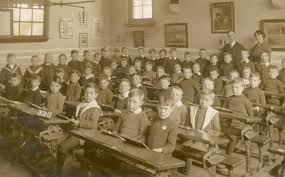 Prior to the 1900’s, the public schools went from a private free enterprise activity with no compulsory attendance laws, no school taxes and independent thinkers to creating complacent ‘good citizens’ that don’t rock the boat, pay their taxes on time and leave politicians to chart the course of the nation.
Prior to the 1900’s, the public schools went from a private free enterprise activity with no compulsory attendance laws, no school taxes and independent thinkers to creating complacent ‘good citizens’ that don’t rock the boat, pay their taxes on time and leave politicians to chart the course of the nation.
Eliminated and brought to extinction was one of the most admirable systematic educational designs developed- the one-room schoolhouses. Here in a small, community environment, children received a cultural local heritage, a sense of community and belonging, personal identity, infinite knowledge and moments of exploration. In addition, youths of all ages learned from each other. There was a passion for learning. This system produced individuals like Thomas Jefferson, Abraham Lincoln and George Washington.
Children valued education initially because it was a wonderful distraction from household and farm chores. There was little competition because young and old assisted each other in the process of learning. This promoted cooperation. Also, teaching others was the key to imprinting knowledge for oneself as the lesson was repeated to someone else. Over and over, younger children benefited from the repetition while the older children performed other lessons. In addition, if a lesson had not been mastered the first time, one could rely on hearing it again. Labels like emotionally disturbed, attention deficit, mentally retarded, were nonexistent because everyone had a sense of equality. The one room schoolhouse contained many children at different age and grade levels working in unison very much a microcosm of the community. (Youths had a short time in school because upon reaching puberty, teens were expected to apprentice in some vocation.)
These were the schools that reflected the community. Although not perfect, everyone had a sense of placement and belonging both at home and in the world. Small classes are special, integrating many ages as well as developing skills of intimacy. How many intimate friends can an individual pursue? Having 3 to 5 close friendships is all anyone can hope to successfully achieve at any given time. In the one room schoolhouse, these relationships were nurtured. In schools, clicks have replaced intimate friendships. The chaos of large environments everyone promotes apathy. One-room schoolhouses were the closest replication of the family of any educational structure.
The teachers were dedicated individuals. For little if any pay, weathering severe conditions like having to chop wood or arrive at 5 A.M. to start a fire or get children home during a snowstorm, teachers in the past were revered individuals. The teacher often resided in someone’s home (even shared a room with the students). Initially, only men were teachers. As teaching evolved, more and more, women were attracted to the profession. Female teachers were unable to marry or have families, as a mothers’ job was considered more valuable for the purpose of maintaining the family structure and community. If a woman had her own children, she could not possibly care for, have time for and devote her herself to educating others. However, the most desirable female in a town for marriage was the teacher!
Although natural, school environments were not the healthiest in the world. Smoke filtered indoors when the fireplace or pot-belly store was lit. The youngest sat in the front of the schoolhouse near the wood stove to keep warm. However, the older students sat in the rear of the room near the door where it was drafty and cold in winter. In the South, schools were dismissed when the temperature was too hot and humid to concentrate. The rooms were sooty and full of dust from the wooden and/or dirt floors and stoves. All in all, indoor environments of one-room schoolhouses had little distinction from the outdoors.
The school was the center and the most utilized building in the community. The court, the Sunday picnic, church services and any important event or situation that needed to be held or discussed transpired in the schoolhouse. Financial, material, scholastic support was distributed among all members as well as the wood for the fire, furnishings and texts. The community decided what was best for the children.
One-room public community schools were varied in form and design. However, there were also private schools held in plantation houses and on large estates. Youths in these schools viewed education very differently. Since recorded history began, the nobility always received the best education of the day whether in Europe, Asia or the America’s, most often males. To become a gentleman or lady was a revered commodity for transferring information, culture and customs from one generation to the next. To have a well bred, educated son or daughter was a measure of wealth, respect and honor.
Children progressed by ability rather than by age. Instead of subjecting the entire class to review math problems, for example, year after year, a child was able to glean from overhearing repetitive lessons taught to younger students pertinent pieces of information for continuity, repetition and continuous flow of whole perspective.
Children were grouped by community rather than by age, grade, physical or learning disability without the added expense of special tutors or specialists.
It was the child’s responsibility to learn no one else.
School was perceived as a privilege although legislated a right. Children attended school only after doing morning chores, community service or tending the fields in the wee hours of the morning.
The sense of community extended itself to having the school as the heart of the community.
Children assisted each other in supportive relationships rather than competition, siblings supporting each other.
The McGuffy Reader of the late 1800’s stressed the development of characters, morals and values in stories. The inherent theme was “We-Us’ rather than the values of today, which are “Me-I” as well as character not personality.
Teachers had high expectations of students and the burden of proof was left to the children not the teacher.
Readers were challenging, stimulating and relevant to daily life.
Labeling of children was nonexistent, assisting each other, especially the young was expected.
Women were unable to be teachers if married because it was felt that the community benefited from mothers at home. And mothers at home were considered unfit for being with children all day and night.
Generations lived within the same household, sometimes up to four, thus bridging the gap between cradle to rocker.
Superior quality of work was more important than the quantity of information memorized
TODAYS EDUCATION
Who can define a ‘good education’? Is the purpose of learning, as in school, for the socializing effect, for the success factor, becoming proficient at test taking, career placement or something else? If history is any indicator at all, some of the most knowledgeable, successful and functional human beings were uneducated by today’s standards. An infamous football coach Vince Lombardy said it best when he sought to hire only PhD’s- Passionate, Hungry and Determined people. Self-motivation, self-fulfillment, drive, passion and embracing life are more apt to measure success than any subjects studied in school. And these skills, although most probably directly unteachable, can be cultivated, nurtured and guided to fruition. The process of learning in the West has become so alien to life, so diluted and devoid of meaning and tangible experiences and more theoretical by design, ( as well as more politically, economically and socially insane), that ‘real-life’ and ‘real-learning’ has become a myth.
Some major factors that deprive the process are rooted in a ‘fear’ pervasive environment that inhibits:
•The ability to question without retribution (authorities, experts, peers)
•The need to fully explore (kinesthetically, mentally, emotionally, physically)
•The longing to feel secure and safe
•The joy to revel in one’s own creativity, intelligence and innovation (instead of those of the past)
•The capacity to honor soft skills (compassion, intuition, integrity, honesty, commitment, service to others, respect) equal to hard skills (physical prowess, intellectual capacity),
•The sense of belonging instead of separate, isolated and alone,
•The introduction to knowledge, skills and experiences at a moment when the organism is incapable of filtering, ordering and assimilating the data with over stimulating the neurology instead.
Although Maslow defined the most obvious human needs, some are so intangible that means of measurement are impossible to standardize. Why is there a national fetish to measure learning in such a manner (except to justify billions of dollars into a system that is irrelevant, archaic, inept and crumbling?) IF education is the measure of learning and socialization, how can a tool of measurement be devised to define when one becomes an adult morally, ethically, emotionally, socially or even intellectually? Tools of measurement are arbitrary, inaccurate, narrow and change with the times. The time for national dialogue and the dissolution of the educational infrastructure is imminent because education is no longer relevant to modern learning.
